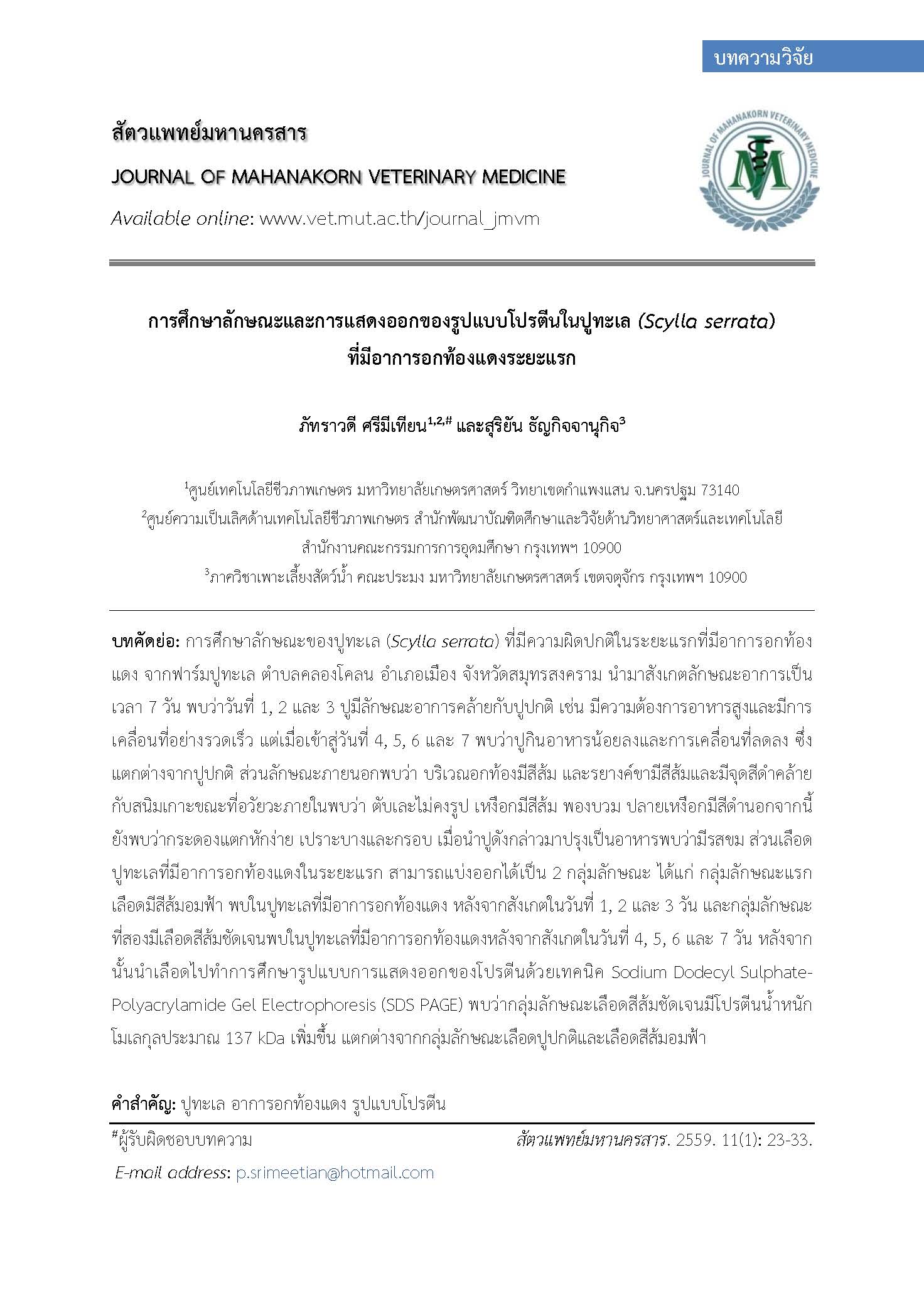การศึกษาลักษณะและการแสดงออกของรูปแบบโปรตีนในปูทะเล (Scylla serrata) ที่มีอาการอกท้องแดงระยะแรก
Main Article Content
บทคัดย่อ
การศึกษาลักษณะของปูทะเล (Scylla serrata) ที่มีความผิดปกติในระยะแรกที่มีอาการอกท้องแดง จากฟาร์มปูทะเล ตำบลคลองโคลน อำเภอเมือง จังหวัดสมุทรสงคราม นำมาสังเกตลักษณะอาการเป็นเวลา 7 วัน พบว่าวันที่ 1, 2 และ 3 ปูมีลักษณะอาการคล้ายกับปูปกติ เช่น มีความต้องการอาหารสูงและมีการเคลื่อนที่อย่างรวดเร็ว แต่เมื่อเข้าสู่วันที่ 4, 5, 6 และ 7 พบว่าปูกินอาหารน้อยลงและการเคลื่อนที่ลดลง ซึ่งแตกต่างจากปูปกติ ส่วนลักษณะภายนอกพบว่า บริเวณอกท้องมีสีส้ม และรยางค์ขามีสีส้มและมีจุดสีดำคล้ายกับสนิมเกาะขณะที่อวัยวะภายในพบว่า ตับเละไม่คงรูป เหงือกมีสีส้ม พองบวม ปลายเหงือกมีสีดำนอกจากนี้ยังพบว่ากระดองแตกหักง่าย เปราะบางและกรอบ เมื่อนำปูดังกล่าวมาปรุงเป็นอาหารพบว่ามีรสขม ส่วนเลือดปูทะเลที่มีอาการอกท้องแดงในระยะแรก สามารถแบ่งออกได้เป็น 2 กลุ่มลักษณะ ได้แก่ กลุ่มลักษณะแรกเลือดมีสีส้มอมฟ้า พบในปูทะเลที่มีอาการอกท้องแดง หลังจากสังเกตในวันที่ 1, 2 และ 3 วัน และกลุ่มลักษณะที่สองมีเลือดสีส้มชัดเจนพบในปูทะเลที่มีอาการอกท้องแดงหลังจากสังเกตในวันที่ 4, 5, 6 และ 7 วัน หลังจากนั้นนำเลือดไปทำการศึกษารูปแบบการแสดงออกของโปรตีนด้วยเทคนิค Sodium Dodecyl Sulphate-Polyacrylamide Gel Electrophoresis (SDS PAGE) พบว่ากลุ่มลักษณะเลือดสีส้มชัดเจนมีโปรตีนน้ำหนักโมเลกุลประมาณ 137 kDa เพิ่มขึ้น แตกต่างจากกลุ่มลักษณะเลือดปูปกติและเลือดสีส้มอมฟ้า
Article Details
เอกสารอ้างอิง
Ayres, P. and Edwards, E. 1982. Notes on the distribution of ‘‘black spot” shell disease in crustacean fisheries. J. Chem. Ecol. 1: 125-130.
Bradford, M.M. 1976. A Rapid and sensitive method for the quantitation of microgram quantities of protein utilizing the principle of protein-dye binding. Anal. Biochem.72: 248-254.
Costa-Ramos, C. and Rowley, A. F. 2004. Effect of Extracellular Products of Pseudo-alteromonas atlantica on the Edible Crab Cancer pagurus. Appl. Environ. Microbiol. 70(2): 729-735.
Department of Fisheries. 2015. http://www. fisheries.go.th/. 12 December 2015.
Intanakom, J. 2010. Study on morphological, bacterial identification and histology in mud crab (Scylla sp.) with red thoracic-abdominal syndrome. The thesis of Kasetsart University.Bangkok. 93 p. (in Thai)
Klose, J. 1975. Protein mapping by combined isoelectric focusing and electrophoresis of mouse tissues. A novel approach to testing for induced point mutations in mammals. Humangenetik. 26(3): 231-243.
Laemmli, U.K. 1970. Cleavage of structural proteins during the assembly of the head of bacteriophage T4. Nature. 227: 680-685.
Liu, W., Qian, D. and Yan, X. 2011. Protemic analysis of differentially expressed proteins in hemolymoh of Scylla serrata response to white spot syndrome virus infection. Aquaculture. 314: 53-57.
Martin, G.G., Hose, J.E., Omori, S., Chong, C., Hoodbhoy, T. and McKrell, N. 1991. Localization and roles of coagulogen and transglutaminase in hemolymph coagulation in decapods crustaceans. Comp Biochem Physiol. 100(B): 517-522.
Merzendorfer, H. and Zimoch, L. 2003. Chitin metabolism in insects: structure, function and regulation of chitin synthases and chitinases. J. Exp. Biol. 206: 4393-4412.
Meyers, T.R., Koeneman, T.M., Botelho, C. and Short, S. 1987. Bitter crab disease: a fetal dinoflagellate infection and marketing problem for Alaska tanner crabs Chionoecetes bairdi. Dis. Aquat. Organ. 3: 195-216.
Noga, E.J., Engel, D.P., Arroll, T.W., McKenna S. and Davidian, M. 1994. Low serum antibacterial activity coincides with increased prevalence of shell disease in blue crabs Callinectes sapidus. Dis. Aquat. Organ. 19: 121-128.
Nonwachai, T. 2010. Growth, survival and non-specific immune characteristics of pacific white shrimp (Litopenaeus vannamei) fed with supplement Sehizochytrium sp. and ARA containing diets, and challenged with Vibrio harveyi. The thesis of Kasetsart University.Bangkok. 113 p. (in Thai)
Plainpun, N. 2014. Induction of red thoracic – abominal syndrome with bacteria isolated from mud crab (Scylla sp.). The thesis of Kasetsart University. Bangkok. 121 p. (in Thai)
Qiao, J., Du, Z., Zhang Y., Du H., Guo L., Zhong M., Cao J. and Wang X. 2011. Proteomic identification of the related immune-enhancing proteins in shrimp Litopenaeus vannamei stimulated with vitamin C and Chinese herbs. Fish & Shellfish Immunol. 31: 736-745.
Ryazanova, T.V. 2008. Bitter crab syndrome in two species of king crabs from the Sea of Okhotsk. Russ. J. Mar. Biol. 34: 411-414.
Salaenoi, J., Sangcharoen, A., Thongpan, A. and Mingmuang, M. 2006. Morphology and haemolymph composition changes in red sternum mud crab (Scylla serrata). KasetsartJ. (Nat. Sci.) 40: 158-166.
Söderhäll, K. and Cerenius, L. 1998. Role of the prophenoloxidase-activating system in invertebrate immunity. Curr Opin Immunol. 10: 23-28.
Somboonwiwat, K., Chikeeratisak, V., Wang, H.C., Lo F.C. and Tassanaka, A. 2010. Proteomic analysis of differentially expressed proteins in Penaeus monodon hemocytes after Vibrio harveyi infection. Proteome Sci. 8: 1-11.
Srimarksuk A. 2012. Growth, survival, non-specific immune characteristics and resistance to Vibrio harveyi of pacific white shrimp (Litopenaeus vannamei) fed with yeast cell debris. The thesis of Kasetsart University.Bangkok. 114 p.
Stentiford, G.D., Green, M., Bateman, K., Small, H.J., Neil, D.M. and Feist, S.W. 2002. Infection by a hematodinium-like parasitic dinoflagellate causes pink crab disease (PCD) in the edible crab Cancer pagurus. J. Invertebr. Pathol. 79: 179-191.
Taylor, A.C., Field, R.H. and Parslow-Williams, P.J. 1996. The effects of Hemato-diniumsp infection on aspects of the respiratory physiology of the Norway lobster, Nephrops norvegicus (L.). J. Exp. Mar. Biol. Ecol. 207: 217-228.
Thammasirirak, S. 2002. Proteomics. KKU Sci. J. 30(3): 160-168. (in Thai)
Vogan, L. C., Costa-Ramos, C. and Rowley, A. F. 2002. Shell disease syndrome in the edible crab, Cancer pagurus – isolation, characterization and pathogenicity of chitinolytic bacteria. Microbiology. 148:743-754.
Xu,W., Xie, J.,Shi H. and Li, C. 2010. Hematodinium infections in cultured ridgetail white prawns, Exopalaemon carinicauda, in eastern China. Aquaculture. 300: 25-31.


